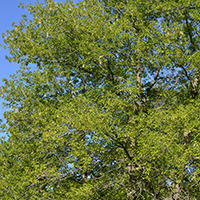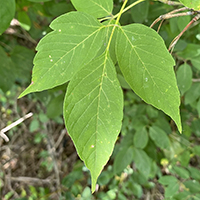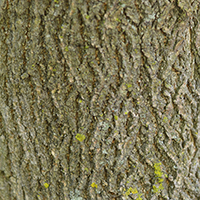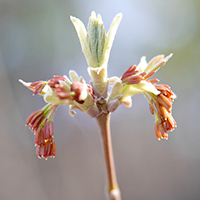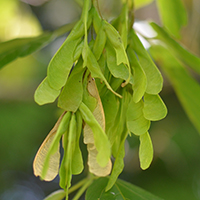What Manitoba maple looks like
Size and shape
- Reaches 20 metres high.
- Trunk reaches up to 75 centimetres in diameter.
Leaves
- Leaves composed of 3 to 9 leaflets on a central stalk (5 to 12 centimetres).
- Light green on top and greyish green on the bottom.
- Leaflets are coarsely toothed or lobed.
- Turn yellow in fall.
Bark
- Light greyish-brown and smooth.
- Becomes darker and furrowed with age.
Flowers
- Small, petal-less flowers that bloom with or before the leaves.
- Male flowers grow as a bundle of single stalks.
- Female flowers grow in clusters.
Fruit
- Joined pairs of winged keys, known as samaras, grow in drooping clusters (wings 30 to 50 millimetres long).
- Wings curve inward.
Where Manitoba maple is found
Manitoba maple trees are native in extreme Northwestern Ontario, and were probably native along the Grand, Thames and Sydenham River floodplains. They are now widely distributed throughout Ontario, including northwest, portions of the northeast, the southern Canadian Shield and all of Southern Ontario.
What you need to know to grow Manitoba maple
- Moisture: grows best in moist, well-drained soil, but tolerates wet conditions once established.
- Soil: adapts to many soil types.
- Shade: grows best in full sun to part shade.
- Caution: Manitoba maple is considered an invasive species across much of its range.
Benefits and uses of Manitoba maple
Wildlife benefits
Manitoba maple samaras are a food source for wildlife including birds and squirrels. Manitoba maple trees are commonly planted in windbreaks, providing wildlife habitat.
Commercial uses
Manitoba maples are tapped to collect sap and produce Manitoba maple syrup. The wood is commonly used to produce:
- ornamental objects
- wood pulp
- boxes
- crates
Fun facts about Manitoba maple
- Manitoba maple trees live up to 60 years.
- Manitoba maple trees are the only native maple species with divided leaves.
Updated: October 17, 2023
Published: July 18, 2014
